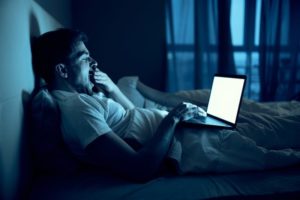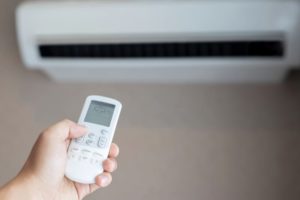Sleeping With the Lights On
- Sleeping with lights on can disrupt your circadian rhythm and hinder sleep quality.
- Artificial light, especially blue light, can suppress melatonin production.
- Excessive light exposure can impact your sleep-wake cycle and negatively affect your overall health.
- An environment that is dark is essential for a better night of sleep.
Sleepers can be exposed to light in a variety of ways, from bright overhead lights and bedside mobile devices to televisions and nearby street lamps. While this may seem common enough, research has shown that sleeping with a light on may affect a person’s health and the quality of their sleep.
What Are the Effects of Sleeping With the Lights On?
Sleeping with the lights on may affect sleep quality and increase the risk of certain health problems, like heart disease. These problems might be the result of disruptions to a person’s internal sleep-wake cycle, which is heavily influenced by exposure to light. Disruptions in the sleep-wake cycle can
change the way the body regulates energy
and maintains the functions of the heart and blood vessels, which can lead to other health problems.
“Literature shows that exposure to light during the night may increase the risk for metabolic conditions such as diabetes, hypertension and obesity.”
Dr. Anis Rehman, Internal Medicine Physician
Heart Health
Preliminary research suggests that even a dim light during sleep can affect how the heart functions. Sleeping with a light on has been shown to increase heart rate and the risk for high blood pressure in some groups. These changes increase the chance of developing heart disease.
More research is needed to understand why light exposure has such an effect on heart health. However, doctors suggest people may be able to reduce the risk of heart disease by minimizing or eliminating exposure to light at night and increasing exposure to natural daylight during the day.
Obesity
Certain types of nighttime light exposure are associated with weight gain or obesity . According to one study, women who fell asleep with a television or a light on were more likely to have obesity and to continue to gain weight. Nighttime use of blue light is also associated with an increased risk of obesity, but sleeping with a small nightlight is not.
More research is needed to understand the potential link between obesity and sleeping while exposed to artificial light. However, doctors recommend reducing light at night as much as possible to lower the risk of weight gain and obesity.
Diabetes
Experts have also found an association between sleeping with the lights on and diabetes . A small study found that insulin resistance may increase when people sleep with a light on. Insulin resistance is a condition where the body does not effectively process sugar and is a risk factor for diabetes. Further research can clarify how long-term use of lights at night is related to diabetes and the development of insulin resistance.
Does Sleeping With the Lights On Have Benefits?
In general, it is best to sleep in darkness with no lights on. However, there are some cases when having lights on may be beneficial. For example, children or adults who are afraid of the dark may need to use a nightlight to help them relax and sleep. Also, some older adults may require a nightlight to prevent falls when getting up in the middle of the night. In these scenarios, experts recommend using a dim, warm-colored light to reduce intense light exposure as the benefits may outweigh the potential harms.

How Light Can Impact Sleep
Light can significantly affect an individual’s circadian rhythm. Circadian rhythms are internal patterns that change over a 24-hour cycle in response to environmental cues. For example, light alerts the body when to be awake while darkness signals the body to feel more tired . So, when a person is exposed to artificial light, it can confuse the body into thinking it should be more awake at times it should be resting.
Biological Clock
The biological clock is a person’s internal clock that regulates circadian rhythms. The biological clock is more sensitive to light about two hours before bedtime, as well as throughout the night and for about one hour after waking up in the morning.
Blue light specifically has the strongest impact on the biological clock and sleep. Blue light is a type of artificial light found in fluorescent and LED lights as well as electronic screens on televisions, computers, and mobile devices. Exposure to blue light during the hours before bedtime can make it difficult to fall asleep or stay asleep .
Exposure to light during the evening and during the first part of sleeping can also delay an individual’s circadian rhythm later . People who experience this type of delay may have decreased sleep duration because they cannot sleep well into the morning due to work or school, and they may feel less alert.
Melatonin
Melatonin is a hormone that the body makes on its own to signal the body when to go to sleep. Sleeping with the light on can reduce or even stop melatonin production . Blue light exposure in particular, which includes light from screens on electronic devices, can suppress melatonin production. When the body does not produce melatonin at night, a person may have a hard time falling asleep.
What to Do If You Can Only Sleep With the Light On
Not everyone is able to sleep without any light on. However, there are ways to reduce the impact of artificial light on sleep. Switching to using red light at night instead of white or blue light can help because red light does not disturb the body’s internal clock.
Additionally, natural light during daytime hours is just as important as reducing bright lights during night time when it comes to sleep health. Experts suggest getting an hour of exposure to natural sunlight every morning.
Other tips for good sleep hygiene include:
- Refrain from caffeine and alcohol before bed
- Get regular exercise, but avoid exercise too close to bedtime
- Try not to eat large meals before bed
- Practice relaxation techniques before bed like meditation, taking a bath, or reading
- Keep the bedroom at a cool temperature for sleeping
- Avoid blue light exposure from electronic screens
If you have any questions about your sleep patterns and your health, consult your doctor or a health care provider.

Still have questions? Ask our community!
Join our Sleep Care Community — a trusted hub of sleep health professionals, product specialists, and people just like you. Whether you need expert sleep advice for your insomnia or you’re searching for the perfect mattress, we’ve got you covered. Get personalized guidance from the experts who know sleep best.
References
9 Sources
-
National Heart, Lung, and Blood Institute. (2022, August 16). Turn off all the lights at night: Your heart will thank you., Retrieved March 15, 2023, from
https://www.nhlbi.nih.gov/news/2022/turn-off-lights-at-night-your-heart-will-thank-you -
National Heart, Lung, and Blood Institute. (2022, March 14). Study: Sleeping with even a small amount of light could harm heart health., Retrieved March 15, 2023, from
https://www.nhlbi.nih.gov/news/2022/study-sleeping-even-small-amount-light-could-harm-heart-health -
National Institutes of Health. (2019, June 18). Artificial light during sleep linked to obesity., Retrieved March 15, 2023, from
https://www.nih.gov/news-events/nih-research-matters/artificial-light-during-sleep-linked-obesity -
Park, Y. M., White, A. J., Jackson, C. L., Weinberg, C. R., & Sandler, D. P. (2019). Association of Exposure to Artificial Light at Night While Sleeping With Risk of Obesity in Women. JAMA internal medicine, 179(8), 1061–1071. Advance online publication.
https://pubmed.ncbi.nlm.nih.gov/31180469/ -
Kim, M., Vu, T. H., Maas, M. B., Braun, R. I., Wolf, M. S., Roenneberg, T., Daviglus, M. L., Reid, K. J., & Zee, P. C. (2023). Light at night in older age is associated with obesity, diabetes, and hypertension. Sleep, 46(3), zsac130.
https://pubmed.ncbi.nlm.nih.gov/35729737/ -
National Heart, Lung, and Blood Institute. (2022, March 24). Your sleep/wake cycle., Retrieved March 15, 2023, from
https://www.nhlbi.nih.gov/health/sleep/sleep-wake-cycle -
National Institute for Occupational Safety Health. (2020, April 1). The color of the light affects the circadian rhythms. Centers for Disease Control and Prevention., Retrieved March 15, 2023, from
https://www.cdc.gov/niosh/emres/longhourstraining/color.html -
Goldstein, C. (2021, November 9). Overview of circadian sleep-wake rhythm disorders. In R. Benca (Ed.). UpToDate., Retrieved March 16, 2023, from
https://www.uptodate.com/contents/overview-of-circadian-sleep-wake-rhythm-disorders -
National Center for Complementary and Integrative Health. (2022, July). Melatonin: What you need to know., Retrieved March 16, 2023, from
https://www.nccih.nih.gov/health/melatonin-what-you-need-to-know










